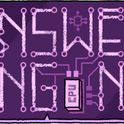Early last year, a mathematician named Timothy Gowers floated an idea on his blog. Gowers writes as you would expect a mathematician to: precise sentences and plenty of caveats. But it was clear that he was proposing something significant. He had come up with a new way of doing mathematics.
Mathematicians tend to be solitary creatures. The stereotype of the lonely thinker holed up in a sparse study is, at least in this field, somewhat justified. The solution to Fermat’s last theorem, one of the most significant achievements of recent decades, was the creation of one man—Andrew Wiles—who toiled alone in an attic for seven years. Now Gowers was offering something completely different: a “massively collaborative” mathematics.
Gowers took an unsolved problem and threw it open, via his blog, to anyone who wanted to try and solve it. Of course, he was not the only mathematician to blog regularly. But he was the first to use it as a collaborative tool. And he did not want to start with anything easy. The goal was to prove part of the Density Hales-Jewett theorem, a thorny problem concerning bizarre structures that are a bit like noughts-and-crosses boards, except that they exist in multiple imaginary dimensions. The theorem says that a game played on one of these boards cannot remain undecided for long, as a player would be forced to make a line after filling only a tiny fraction of the board. The problem has no immediate practical application, but the field from which it is drawn—combinatorics—is a powerful tool for researchers in areas such as computer science and genetics. And it had defeated top mathematicians for years, including Gowers, who has won the Fields Medal, his discipline’s most prestigious prize.
On 1st February, Gowers started a series of posts outlining the problem. Then he waited. At first nothing happened. After seven hours the first comment arrived. But what started soon snowballed. Five weeks later, almost 30 people had made some 800 significant contributions. In March, Gowers declared the problem solved. “That is not the time that sort of problem is supposed to take,” he said afterwards.
Could the team have achieved the same result by sitting down together? Perhaps. Maybe they just got lucky. But the success of the Polymath project, as Gowers calls his experiment, may mean something more.
An online dialogue is stretched out in time; a conversation with long pauses between contributions. This allows the freedom to think before replying, which gives younger and less established participants the confidence to chip in. It also allows for more reflective and thoughtful responses. Michael Nielsen, a physicist who is working on a book about the future of science, thinks that the Polymath approach will make maths more efficient. He likens collaboration between mathematicians to a market of buyers and sellers. Researchers have knowledge that their peers can make use of, but, like traders of real goods, they can’t do business unless they can communicate. Just as reducing barriers to communication makes markets more efficient and increases economic wealth, online collaboration can boost mathematical wealth.
While many businesses and creative industries have already latched on to this, there are now tentative signs that science is catching on too. Some chemistry labs have “open notebooks”: online records of their experiments, accessible to all. Garrett Lisi, a theoretical physicist who is trying to combine quantum mechanics and general relativity into a “theory of everything,” takes a similar approach. And nearly 3,000 questions have been submitted to Math Overflow, a website where mathematicians discuss bite-sized problems. At least four more Polymath projects are now underway, with several more being developed. The model might also turn out to be suited to related fields like theoretical physics.
But even if subsequent projects fail to replicate the speed of the original, Polymath should remind us that collaboration has much to offer. At several key moments in Wiles’s seven-year journey with Fermat’s last theorem, he needed help to continue. A glance at a paper by another mathematician provided inspiration; a chance comment by his old supervisor alerted him to work that proved critical. And with Gowers’s Polymath project, the churn of ideas was far more rapid than a mathematician working alone could ever have achieved. Proposals were made and abandoned almost daily. The system seemed to eliminate the blank moments that all mathematicians experience, the times when they say they feel like a blind man stumbling around an unfamiliar room. “As a solitary mathematician I really do spend a lot of time thinking about what on Earth I’m going to do next,” says Gowers. “That didn’t happen during Polymath.”
Go figure
The web could revolutionise the way we solve the world’s toughest mathematical problems
January 27, 2010











